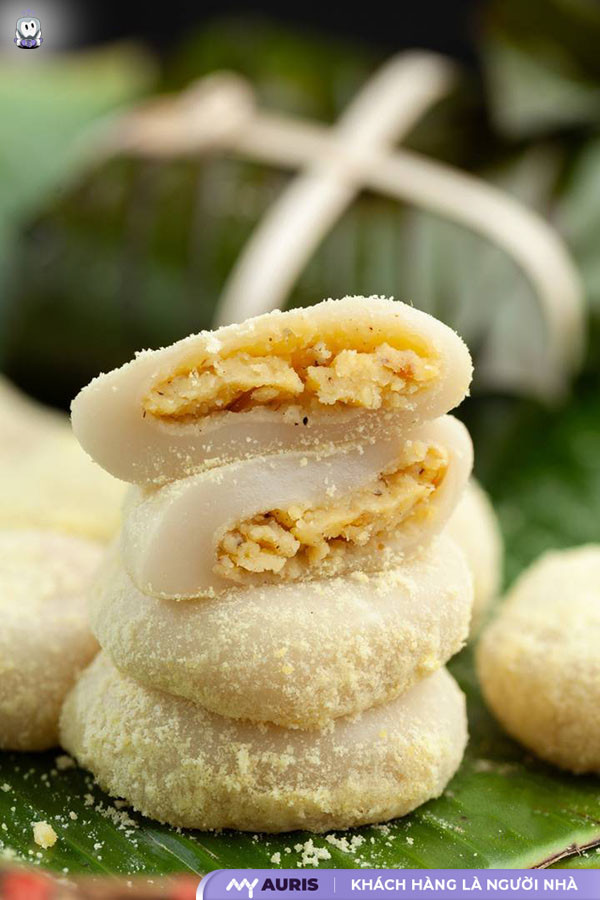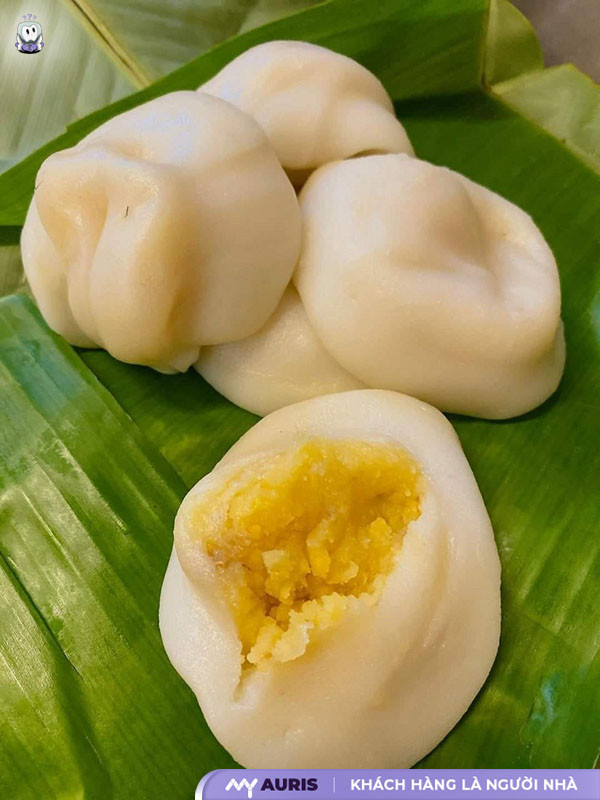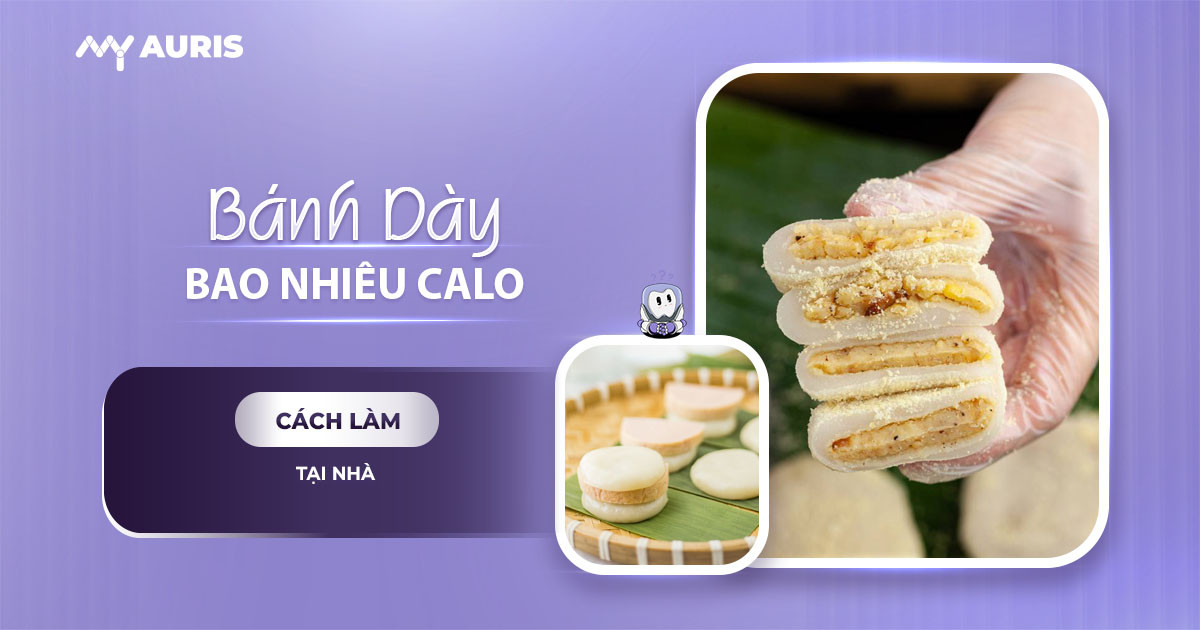Banh Day is a familiar dish found on ceremonial trays and as breakfast for many Vietnamese families. However, many people on a diet or managing their weight often wonder how many calories are in Banh Day and if it can lead to weight gain. This article by Nha Khoa My Auris will help you understand the nutritional value and calorie content of each type of Banh Day.
How Many Calories Are In Banh Day?
Banh Day is a traditional dish beloved by many for its chewy texture, fragrant taste, ease of eating, and long-lasting fullness. However, many people wonder about Banh Day’s calorie content and which filling to choose to suit their diet. On average, one Banh Day contains 180-370 calories, depending on whether it has a savory or sweet filling, as well as the proportion of ingredients used. Below is the detailed calorie content for some popular types of Banh Day:
- Green bean paste Banh Day (100g): With a soft, smooth sweet filling made from green beans, this dish is often chosen for a light snack, providing about 180 calories.
- Banh Day with “chả” (Vietnamese pork sausage): This is a popular breakfast dish due to its satisfying fullness, ease of eating, and non-greasy taste. On average, a pair of Banh Day with “chả” contains about 350 calories/pair.
- Banh Day with “giò” (Vietnamese ham/sausage) (100g): With a fragrant and fatty layer of “giò”, this type of Banh Day provides about 360 calories.
- Banh Day with meat (100g): When combined with meat, this dish has a richer flavor and contains about 320 calories.

Does Eating Banh Day Cause Weight Gain?
Many people worry if eating Banh Day will make them gain weight. However, in reality, 100g of Banh Day contains only about 180-320 kcal, which is lower than the calorie requirement for a typical meal. Therefore, if you control your portion size appropriately, enjoying this dish will not lead to weight gain.
However, if you eat too much Banh Day in one sitting, the excess energy will be converted into accumulated fat by the body, which can eventually lead to weight gain. Furthermore, glutinous rice – the main ingredient of the cake – is inherently difficult to digest. Excessive consumption can easily cause bloating, flatulence, and an increased risk of unintentional weight gain.
Comparison with Other Popular Breakfast Dishes
Below is a quick comparison of the calorie content between Banh Day and other common breakfast dishes:
| Dish | Average Calorie Content (1 serving) | Notes |
| Vegetarian Banh Day | 120 – 150 calories | Low calorie, fast-digesting carbs |
| Banh Day with “giò”/”chả” | 250 – 300 calories | High calorie, high fat |
| Egg sandwich | 300 – 350 calories | High in fat |
| Steamed bun with meat filling | 280 – 320 calories | Contains protein, high in sodium |
| Banh Gio | 250 – 270 calories | High in starch, less filling |
| Banh Chung | 300 – 350 calories | Rich in starch and fat |
| Savory Sticky Rice (Xôi mặn) | 350 – 450 calories | High in protein and fat |
| Beef noodle soup (Bún bò)/Pho | 400 – 500 calories | Rich in nutrients |
| Plain porridge + egg | 180 – 220 calories | Light, easy to digest |
| Boiled egg + banana | 160 – 200 calories | Low calorie, suitable for dieting |

Who Should Limit Banh Day Consumption?
People managing weight or on a diet: For those following a weight-loss regimen, careful consideration is needed because Banh Day contains many carbohydrates and little fiber, causing a rapid increase in blood sugar after eating. This can lead to the body accumulating animal fat and excess energy if consumed regularly. Therefore, dieters should limit their weekly Banh Day intake and avoid using it as a main meal substitute.
People with diabetes, high blood fat, or metabolic disorders: The rapidly absorbed starch from glutinous rice in Banh Day causes a sudden spike in blood sugar after a meal. For diabetic patients, this is a dangerous factor as it directly affects HbA1c levels and blood sugar control. Furthermore, Banh Day with “giò” or Banh Day with “chả” often contain high levels of sodium and saturated fat, which can increase the risk of atherosclerosis and high blood pressure.
Individuals with a history of high blood fat should avoid Banh Day served with “giò” because “giò” typically contains a lot of animal fat and cholesterol. If you truly wish to enjoy it, prioritize vegetarian Banh Day and consume only a small amount.
People with a weak digestive system: Glutinous rice is chewy and difficult to digest. Eating it on an empty stomach or in the evening can cause bloating and indigestion. For the elderly, young children, or those recovering from illness, this dish can easily put strain on the digestive system.
Pregnant women should consider carefully: Although Banh Day is a familiar folk dish for many festive occasions, pregnant women should consult a doctor before consuming it regularly. The reason is that glutinous rice contains a lot of energy but lacks essential micronutrients like calcium, iron, and folic acid. If only Banh Day is eaten for breakfast without accompanying vegetables and protein, it can lead to nutritional imbalance throughout the day.

How to Make Low-Fat Banh Day at Home
Ingredients to prepare:
- 200g brown glutinous rice or regular glutinous rice, thoroughly soaked (brown glutinous rice has fewer rapidly absorbed carbohydrates)
- 1/2 teaspoon pink salt
- 1 teaspoon olive oil (replacing pork fat)
- Banana leaves (for wrapping and steaming)
- Filling (optional): skinless chicken “chả”, steamed green beans, or plain without filling
Steps to follow:
Step 1: Soak and cook glutinous rice
Soak glutinous rice overnight (about 8 hours). Then, steam the glutinous rice in a steamer for 25–30 minutes until cooked. Do not cook it in a rice cooker as it will make the cake lose its chewiness.
Step 2: Mash thoroughly
While still hot, mash the glutinous rice with a mortar and pestle or use a powerful food processor. Add a little olive oil for shine.
Step 3: Form the cakes
Divide the dough into small portions and flatten them by hand. If using a filling like chicken “chả” or green beans, place it in the center and wrap it up. Avoid using pork “chả lụa” as it contains a lot of animal fat and sodium.
Step 4: Steam again
Arrange the cakes on banana leaves and steam for another 10 minutes to ensure they are thoroughly cooked, soft, and warm.





